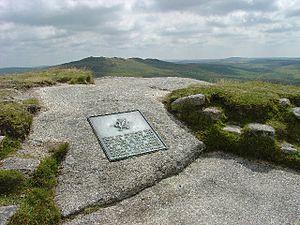Rough Tor facts for kids
Rough Tor, also called Roughtor, is a special type of rocky hill called a tor. It is found on Bodmin Moor in Cornwall, United Kingdom. This amazing place has a hill summit, a logan stone (a huge rock that can rock), and many ancient remains.
You can find a neolithic (New Stone Age) tor enclosure here. There are also many Bronze Age hut circles, which are the foundations of old homes. Plus, there are other important monuments from different times.
Contents
What is Rough Tor Like?
Rough Tor is about one mile northwest of Brown Willy, which is Cornwall's highest point. Both hills are located in the area of St Breward and close to the town of Camelford. The top of Rough Tor is 1313 feet (400 meters) above sea level. This makes it the second highest point in all of Cornwall!
The De Lank River starts nearby and flows between Rough Tor and Brown Willy. Rough Tor and Little Rough Tor are like twin peaks on a big granite ridge. But there are actually three tors here: Showery Tor, Little Rough Tor, and Rough Tor. Crowdy Reservoir and the Lowermoor Water Treatment Works are also close by.
How Can You Visit Rough Tor?
Many people enjoy hiking to the top of Rough Tor and to nearby Brown Willy. The walk can be a bit tough, but it's worth it for the views. There's a road that makes it easy to get to a car park. From the car park, it's about a mile and a half to the summit.
What Ancient History Can You Find at Rough Tor?
From the top of Rough Tor, you can see many signs of old settlements. You can also spot ancient field systems. This tells us that many people lived in this area a very long time ago.
Rough Tor in the Stone Age (Neolithic Period)
The summit of Rough Tor once had a neolithic tor enclosure. This means the top of the hill was surrounded by rough stone walls. These walls followed the natural rock formations. The walls would have completely circled the tor. They also had many openings lined with stones.
Inside this stone circle, there are remains of terraces. These were flat areas built into the slopes. Archaeologists believe these terraces were the foundations for round wooden houses. There are also cleared areas near the terraces that might have been garden plots.
Rough Tor in the Bronze Age
The Rough Tor enclosure is in an area full of other ancient sites from the Bronze Age. For example, the Fernacre stone circle is only 200 meters away. The Stannon stone circle is also nearby. You can also find many cairns (piles of stones) and burial monuments in the area.
On the southern slopes of Rough Tor, you can see the remains of many stone hut circles. These were grouped around three or four enclosures, which might have held farm animals. There are also remains of a large field system. Some of these fields were later used in medieval times. Experts still discuss whether these fields were used for growing crops or for keeping animals.
Rough Tor in Medieval Times
The top of Rough Tor was once home to a medieval chapel. This chapel was built into the side of one of the cairns. It was dedicated to St. Michael. Records from the 14th century mention this chapel. It is the only known hilltop chapel on Bodmin Moor. Since it overlooked an old track across the moor, it might have helped guide travelers.
There are also remains of a second medieval building at the bottom of the summit. A beacon (a signal fire) might have been kept here or at the summit by a hermit. A medieval field system, with straight lines, lies over the older Bronze Age fields at Rough Tor. Several medieval items have been found here, like the base for a stone cross and a small stone cross.
What Modern Memorials Are at Rough Tor?
A special memorial stands below Rough Tor. It remembers the soldiers of the 43rd (Wessex) Division. These brave men lost their lives during the Second World War in Europe in 1944 and 1945. The memorial says:
- ROUGH TOR ON WHICH THIS
- MEMORIAL IS PLACED HAS
- BEEN GIVEN TO THE NATION
- IN MEMORY OF THOSE WHO
- LOST THEIR LIVES WHILE
- SERVING IN THE 43RD (WESSEX)
- DIVISION IN THE NORTH-WEST
- EUROPEAN CAMPAIGN 1944/5
There is also a memorial for Charlotte Dymond. She was sadly murdered on the Tor in 1844.
In 2007, the TV show Time Team explored Rough Tor. They investigated a 500-meter cairn and a Bronze Age village site on its slopes.
Did you know there's another Rough Tor? It's on Dartmoor in Devon, about three miles west of Postbridge. Also, an early name for Mount Barrow in Tasmania, Australia, was 'Row Tor'. It's thought to be named after Rough Tor by Matthew Flinders.




